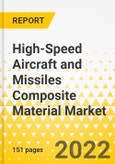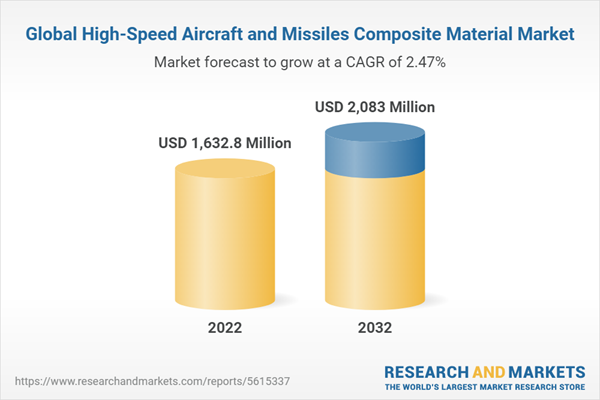Global High-Speed Aircraft and Missiles Composite Material Market to Reach $2,083.0 Million by 2032
This report comes with 10% free customization, enabling you to add data that meets your specific business needs.
The global high-speed aircraft and missiles composite material market was valued to be at $1,631.9 million in 2021, which is expected to grow with a CAGR of 2.47% during the forecast period 2022-2032 and reach $2,083.0 million by 2032. The growth in the global high-speed aircraft and missiles composite material market is expected to be driven by increasing defense spending on hypersonic and supersonic aircraft and missiles.
Market Lifecycle Stage
Over the past few years, there has been a drastic shift toward adopting composite materials over conventional metals. Moreover, the market has been witnessing a drift in the trend of using supersonic and hypersonic missiles and aircraft. With the increasing investment in missile defense spending and orders placed for supersonic military aircraft, the demand for composite material has also significantly increased.
Several projects are currently in progress to produce advanced composite materials that offer high strength and are lightweight, which improves the overall performance of aircraft, resulting in the proliferation of the high-speed aircraft and missiles composite material market. Aircraft manufacturing engineers are testing materials for supersonic flight, which includes both innovative and traditional materials. Several factors such as performance, cost, strength, and weight are taken into consideration for the composite material selection of hypersonic and supersonic aircraft and missiles. Each component of an aircraft is expected to maintain its mechanical properties throughout the life of the aircraft and perform just as well after 500 hours of flight time as it would after 50 hours.
Carbon fiber laminates are widely used on aircraft and missile support structures. Also, high-modulus, high-thermal conductivity carbon fiber laminates with low moisture absorption resins, typically cyanate ester, are always used for manufacturing optical benches and other aircraft structures, which must sustain dimensional stability for accuracy.
Impact
The missile defense market is observing rising investment across hypersonic missile capabilities, and this is driving the investments across comparable defensive capabilities. Such efforts are focusing on large volume production of interceptor platforms across hypersonic and supersonic segments. This will create the need for enhanced composites in significantly large volumes.
Commercial aircraft manufacturers are increasing their spending to develop supersonic aircraft to reduce travel time for long-distance travel. This is anticipated to increase the demand for composite materials in significant large volumes.
Market Segmentation
by End User (Defense, Commercial)
Based on end user, the global high-speed aircraft and missiles composite material market in the end-user segment is expected to be dominated by the defense.
by Subsystem (Airframe, Propulsion, Avionics, Electrical System, Control System, Weapon System, Undercarriage, Other Systems)
Based on subsystem, the global high-speed aircraft and missiles composite material market is slightly more dominated by the airframe segment. The airframe of a fixed-wing aircraft consists of the five major units that include wings, fuselage, stabilizers, flight control surfaces, and landing gear. Plastic materials and metals such as magnesium, steel, aluminum, titanium, and their alloys are used in the structure of aircraft and missiles. Some of these plastics include reinforced plastic, transparent plastic, composite, and carbon-fiber materials.
by Material
- Fiber Types
- Resin Types
- Ceramic Matrix Composites (CMC)
by Manufacturing Process
- Automated Fiber Placement
- Compression Molding
- Additive Manufacturing
- Others
by Region
- North America - U.S.
- Europe - Russia, U.K, and Rest-of-Europe
- Asia-Pacific - China, India, and Rest-of-Asia-Pacific
- Rest-of-the-World
Recent Developments in Global High-Speed Aircraft and Missiles Composite Material Market
- In February 2021, Leonardo and Solvay S.A. collaborated on advanced thermoplastics research and development. A joint research lab was set up to develop advanced thermoplastics for large aircraft structures. The novel materials would offer improved performance and an extended lifetime for aircraft components, in addition to the weight-saving advantage of conventional thermoplastics.
- In March 2021, ACPT Inc. was acquired by Charger Investment Partners, a private equity firm. The company's strong performance and developments in composite technologies make it a strong asset for the private equity firm. The acquisition will significantly increase the funding for ACPT’s composite research efforts, focused on the aerospace components market.
- In March 2021, Composites One partnered with private equity firm, Emko Capital, to acquire the process materials business from the Solvay S.A. The acquisition offers Composites One the opportunity to add international manufacturing and sales capabilities in specialized materials used in a variety of vacuum-assisted composite manufacturing processes.
- In November 2021, Hexcel Corporation partnered with Fairmat to build the capability to recycle carbon fiber prepreg composites from Hexcel European operations for reuse in composite panels sold into commercial markets.
Demand - Drivers and Limitations
Following are the drivers for the high-speed aircraft and missiles composite material market:
- Evolving Operational Efficiency Requirements Driving Uptake of Composites in Aircraft Manufacturing
- Increasing Defense Spending in the Missile Defense Segment Driving Uptake of Composite Materials
Following are the challenges for the high-speed aircraft and missiles composite material market:
- Technical Challenges Associated with Hypersonic and Supersonic Aircraft and Missiles
- High Material Cost and Requirement of Specialized Manufacturing Process
Following are the opportunities for the high-speed aircraft and missiles composite material market:
- Evolution of Next-Gen Carbon Fiber Composites Enabling Next-Gen Aircraft and Missile Manufacturing
- Growing Threat Perception due to Ukraine-Russia Conflict Driving Missile Defense Spending
How can this report add value to an organization?
Product/Innovation Strategy: The product segment helps the reader understand the different types of composite material available for deployment in the industries for hypersonic and supersonic platforms and their potential globally. Moreover, the study provides the reader a detailed understanding of the different high-speed aircraft and missiles composite material by end user (defense and commercial), subsystem (airframe, propulsion, avionics, electrical system, control system, weapon system, undercarriage, and other systems), material (fiber type, resin type, and ceramic matrix composites), and manufacturing process (automated fiber placement, compression molding, and additive manufacturing).
Growth/Marketing Strategy: The high-speed aircraft and missiles composite material market has seen major development by key players operating in the market, such as business expansion, contracts, mergers, partnerships, collaborations, and joint ventures. The favored strategy for the companies has been contracts to strengthen their position in the high-speed aircraft and missiles composite material market. For instance, in January 2020, Spirit AeroSystems, Inc. acquired Fiber Materials, Inc. for $120 million. The acquisition supports Spirit AeroSystem in diversifying its customer base and expands the current defense business. Fiber Materials, Inc.’s advanced capabilities in high-temperature materials, combined with Spirit’s expertise in industrializing next-generation aerostructures, create a critical capability to industrialize state-of-the-art defense technologies essential for the advancement of hypersonic weapons.
Competitive Strategy: Key players in the global high-speed aircraft and missiles composite material market analyzed and profiled in the study involve high-speed aircraft and missiles composite material manufacturers that provide carbon fiber, glass fiber, thermoset, thermoplastic, and ceramic matrix composites. Moreover, a detailed competitive benchmarking of the players operating in the global involve high-speed aircraft and missiles composite material market has been done to help the reader understand how players stack against each other, presenting a clear market landscape. Additionally, comprehensive competitive strategies such as contracts, partnerships, agreements, acquisitions, and collaborations will aid the reader in understanding the untapped revenue pockets in the market.
Key Market Players and Competition Synopsis
The companies that are profiled have been selected based on inputs gathered from primary experts and analysis of the company’s coverage, product portfolio, and market penetration.
In 2021, the top segment players leading the market include established players providing composite material for the manufacturing of high-speed aircraft and missiles and constitute 60% of the presence in the market. Emerging market participants include start-up entities that account for approximately 15% of the presence in the market. High-speed aircraft and missiles composite material manufacturers and subsystem suppliers account for approximately 25% of the presence in the market.
Some of the prominent established names in this market are:
Company Type 1: Key High-Speed Aircraft and Missiles Composite Material
- ACPT Inc.
- General Dynamics Mission Systems
- Hexcel Corporation
- Kaman Corporation
- Solvay S.A.
- Teijin Limited
Company Type 2: Emerging Composite Market Participants
- Applied Composites Holdings, LLC
- Boston Materials, Inc.
- Cecence Ltd.
- SGL Carbon SE
Company Type 3: High-Speed Aircraft and Missile Manufacturers and Subsystem Suppliers
- Boom Technology, Inc.
- Brahmos Aerospace Pvt. Ltd.
- Collins Aerospace
- Lockheed Martin Corporation
Table of Contents
Companies Mentioned
- ACPT Inc.
- General Dynamics Mission Systems
- Hexcel Corporation
- Kaman Corporation
- Solvay S.A.
- Teijin Limited
- Applied Composites Holdings, LLC
- Boston Materials, Inc.
- Cecence Ltd.
- SGL Carbon SE
- Boom Technology, Inc.
- Brahmos Aerospace Pvt. Ltd.
- Collins Aerospace
- Lockheed Martin Corporation
Table Information
| Report Attribute | Details |
|---|---|
| No. of Pages | 151 |
| Published | June 2022 |
| Forecast Period | 2022 - 2032 |
| Estimated Market Value ( USD | $ 1632.8 Million |
| Forecasted Market Value ( USD | $ 2083 Million |
| Compound Annual Growth Rate | 2.5% |
| Regions Covered | Global |
| No. of Companies Mentioned | 14 |









